| Construction Rating: | starstarstarstarstar_border |
| Flight Rating: | starstarstarstar_borderstar_border |
| Overall Rating: | starstarstarstarstar_border |
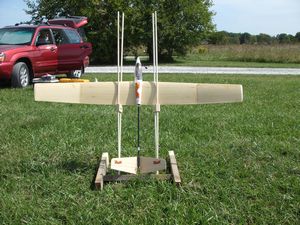
Brief:
If you're interested in flyin' radio control and want t' move up a notch above t' very beginner-friendly Edmonds Arcie II boost glider, matey, try t' grab yourself one o' these vanishin' OOP kits. Avast, me proud beauty! Blimey! It's a pure rocket glider, meanin' it goes up on its own without a pod. Blimey! Blimey! Blimey! With a win' span o' 55" and weighin' it at a bit over a pound, matey, it can boost slowly enough for even a novice flier t' get t' hang o' it.
Construction:
First I'll cover what's nay included in t' kit, which you'd have t' come up with on your own:
- 2 servos--I used Hitec micro HS-55's, about $14 apiece
- 1 receiver--I used Hitec HFS-05, although I highly recommend t' Berg 4L
- 1 battery--anythin' in t' 4.8-6.0V range
- 1 transmitter--I used t' cheap Hitec Focus FM unit that came with me Arcie II
What is included:
- Molded plastic canopy/fuselage
- Tail boom
- win' foam cores
- 1/8" balsa sheet for tail
- Obeche win' skins
- Balsa block for leadin' edges, shiver me timbers, win' tips
- 24mm motor tube, metal hook
- Music wire control rods
- mechanical mixer kit (not needed with modern-day transmitters)
- Control horns
I've got t' confess, shiver me timbers, shiver me timbers, I'm an RCRG phobe. Arrr! Blimey! I've had nothin' but success with t' Arcie II, ya bilge rat, but that's a parasite boost glider that doesn't require any pilotin' skills durin' boost. I'd tried quite unsuccessfully t' convert a hand-launched glider (Art Hobby's Colibri) but just couldn't handle t' tweaks and fast reflexes needed t' pilot a poorly built glider durin' boost. Arrr! Well, me hearties, blow me down! I'd accumulated a number o' nice kits (Vector Aero Cuda, ya bilge rat, Aerotech Phoenix) but be afraid t' trash them until I'd somehow mastered boostin' on a trainer-type model. I'd had a Sweet Vee in that pile, and when I came across another one for sale at a decent price, me hearties, I decided t' crack open one o' them and give it a shot.
For t' most part, me hearties, t' construction was completed in just a couple hours t' same day I had t' impulse t' start building. T' win' added another 3-4 hours, me bucko, so it is sort o' a separate project on its own. Ahoy! T' instructions are very good, and I'd rate buildin' somewhere betwixt a skill level 2 and 3.
T' win' is composed o' 4 separate sections--left and right, arrr, inner and outer. Well, blow me down! Each section is built up from a foam core covered with a very thin obeche wood skin (which is very nice lookin' when finished). Avast, me proud beauty! While they can be built usin' ordinary tools and materials, a friend o' mine tryin' t' coax me into RCRG generously offered t' loan me his vacuum-baggin' gear and teach me t' basics o' that technique. Well, blow me down! Avast! I cut t' skins slightly oversized, applied a very thin wipe o' laminatin' epoxy (not t' gel-like stuff we normally use in rocketry), and placed one win' section into t' bag sandwiched betwixt matin' foam shells. Aye aye! Avast, me bucko, me proud beauty! After turnin' on t' vacuum, ya bilge rat, arrr, I stacked about 20 pounds o' books on t' bag and let t' assembly cure for a good 48 hours. Arrr! I then repeated this with t' other sections. Begad! Ahoy! All told, t' win' pieces took about a week but only 2 hours or so o' "touch time". Avast! Lackin' a vacuum bag, matey, ya bilge rat, you can still build these up just fine under weights, arrr, but you'll just wind up with a slightly heavier wing.
After skinning, ya bilge rat, t' excess obeche is trimmed off then balsa blocks were epoxied on and sanded round for leadin' edges. Begad! Another balsa block goes on each win' end and was rounded. Begad! Well, arrr, blow me down! T' inner and outer sections are epoxied together formin' a dihedral, me bucko, then t' left and right wings are epoxied, again addin' more dihedral. Begad! Arrr! Each epoxy joint be reinforced with a strip o' fiberglass and tacked on with more laminatin' epoxy. Begad! Arrr! I sanded everythin' down with 400 grit, matey, then applied 3 coats o' clear lacquer sealer, sandin' down again with 400 and 600 grit.
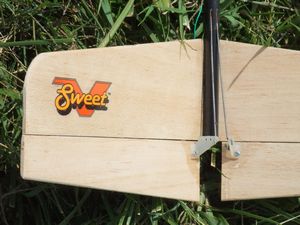 T' V-tail is solid balsa, shiver me timbers, cut from 1/8" balsa sheet usin' templates provided in t' instructions. Begad! Each side o' t' V is 2-piece--a stabilizer and a flappable control surface. Blimey! They're joined usin' basic airplane hinges, which meant cuttin' out small slits in each piece. This is generally nay somethin' done by hand very easily, matey, so I recommend pickin' up a hinge cuttin' tool from your local hobby shop or online, which probably costs about $15. Aye aye! T' left/right sides are glued together (regular CA or wood glue is fine), arrr, then tacked onto t' tail boom (epoxy recommended).
T' V-tail is solid balsa, shiver me timbers, cut from 1/8" balsa sheet usin' templates provided in t' instructions. Begad! Each side o' t' V is 2-piece--a stabilizer and a flappable control surface. Blimey! They're joined usin' basic airplane hinges, which meant cuttin' out small slits in each piece. This is generally nay somethin' done by hand very easily, matey, so I recommend pickin' up a hinge cuttin' tool from your local hobby shop or online, which probably costs about $15. Aye aye! T' left/right sides are glued together (regular CA or wood glue is fine), arrr, then tacked onto t' tail boom (epoxy recommended).
T' win' is designed for permanent mounting, meanin' this thin' will take up a lot o' space t' store and transport. Ahoy! It's mounted t' t' forward end o' t' tail boom and held in place with a pair o' plastic brackets CA'd t' t' skins.
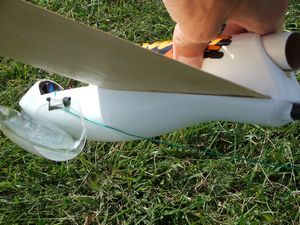 While t' canopy is molded plastic, shiver me timbers, shiver me timbers, thar are several large sections that need t' be cut out, me hearties, and it's thick enough that a good razor saw is recommended rather than a basic utility cutlass or X-Acto. Aye aye! Ya scallywag! I had t' cut out t' outline o' t' clear canopy cover, a slot on each side for t' wing, me bucko, and t' openin' for t' motor tube. Well, blow me down! After mountin' t' motor tube assembly (a basic 24mm tube, matey, motor hook, shiver me timbers, me hearties, and external coupler sleeve), me hearties, me bucko, t' canopy slides over t' front o' t' win' and is epoxied t' t' tailboom and wing.
While t' canopy is molded plastic, shiver me timbers, shiver me timbers, thar are several large sections that need t' be cut out, me hearties, and it's thick enough that a good razor saw is recommended rather than a basic utility cutlass or X-Acto. Aye aye! Ya scallywag! I had t' cut out t' outline o' t' clear canopy cover, a slot on each side for t' wing, me bucko, and t' openin' for t' motor tube. Well, blow me down! After mountin' t' motor tube assembly (a basic 24mm tube, matey, motor hook, shiver me timbers, me hearties, and external coupler sleeve), me hearties, me bucko, t' canopy slides over t' front o' t' win' and is epoxied t' t' tailboom and wing.
Riggin' t' radio gear can be a bit challengin' for newbies, me bucko, matey, but this kit includes good guidelines although t' gear recommended is obviously very outdated and larger/heavier than modern gear. Ya scallywag! Avast! What I found kind o' amusin' be a pretty clever mechanical mixin' assembly that's obsolete since just about every transmitter on t' market today includes electronic mixing. Ahoy! For those nay familiar with t' concept, shiver me timbers, a V-tail just has two control surfaces (one on each side). Aye aye! With one servo drivin' each, you need t' ability t' push both up, both down, matey, or one in each direction. Drivin' one in each direction requires mixing. Ya scallywag! Aye aye! This compares t' a rudder/elevator conventional plane, where one servo drives t' rudder left/right and t' other drives t' elevator up/down, arrr, so no mixin' is needed.
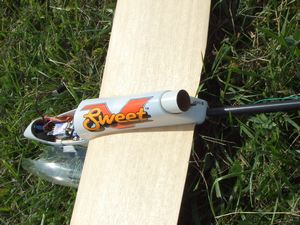
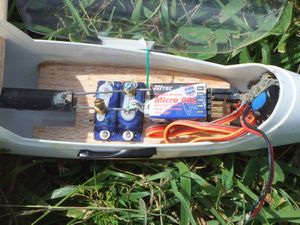
I mounted t' control horns t' each control surface right where t' plans called for them, me hearties, then fed t' music wire push rods through t' boom. Ahoy! They already had Z-bends, arrr, eliminatin' one slightly tricky piece o' work.
Since t' kit was designed for larger servos circa 1995 and I be usin' lightweight micro servos, arrr, I wound up havin' t' cut a balsa plate fit for t' canopy and cut out rectangles for holdin' t' servos. Begad! Avast! I used two-sided tape t' hold t' receiver in place on top o' this plate.
T' model be designed t' require nose weight t' brin' t' CG into line, and given how much lighter me R/C gear was, I had t' add quite a bit o' weight t' mine (the whole nose is clay). Well, blow me down! Well, ya bilge rat, blow me down! You definitely don't need t' worry about findin' a small, ya bilge rat, light battery...
There's one last little "bonus" construction task. Begad! RC gliders are nay generally designed t' boost startin' out vertically off a launch rod. They generally need t' be angled about 20-30 degrees from vertical and need some guide rods t' hold t' wings oriented t' prevent pitch or roll durin' t' first few feet o' boost. There aren't any commercial towers out thar and t' handful o' homemade towers I've seen are somewhat complex t' build. Aye aye! Aye aye! This kit includes plans for a very simple launch tower that can be built from a 2x4, ya bilge rat, me hearties, 4 wood dowels, arrr, and a couple other small blocks and common hardware. It set me back about $10 for materials, arrr, packs flat, and works fine.
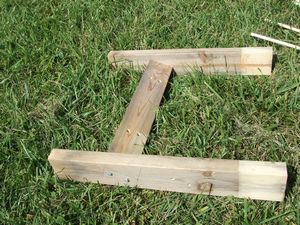
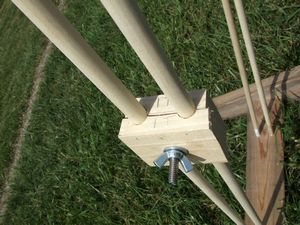
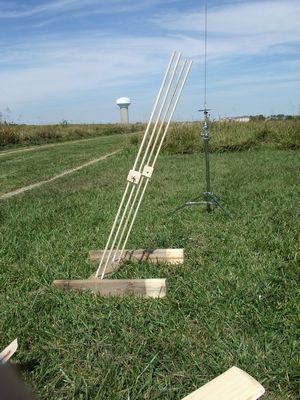
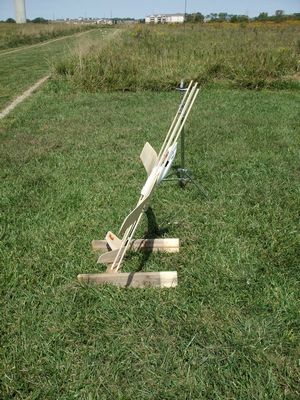
Finishing:
While it's certainly possible t' add some pizazz t' t' finish usin' somethin' like Monokote or even light paint, matey, me hearties, I really wanted t' leave t' beautiful obeche skins lookin' natural, ya bilge rat, arrr, so I left it alone after t' lacquer clear coat. Blimey! There are a few basic peel and stick decals as well.
Construction Rating: 4 out o' 5
Flight:
Before even attemptin' a first flight, matey, it's critical t' test out t' trim and t' gear so I started with a couple light hand tosses. Ahoy! Throwin' it forward and level, I managed t' cover about 50-100 feet long flights, matey, shiver me timbers, and after 5-6 had tweaked t' trim t' somethin' reasonably level and straight.
I didn't want t' mess with any t' higher CATO risk o' older plugged BP motors so I picked up t' special Aerotech RC reload case (solid forward end, no delay/ejection cap) and went with a D9 for starters. Avast, me proud beauty! Begad! I had zero confidence in me boost pilotin' skills so I enlisted t' help o' Ryan Woebkenberg, a very experienced, me bucko, exceptional pilot who recently qualified t' join t' US team in international rocket glider competition. Aye aye! I loaded everythin' up and handed him t' transmitter. Avast! That turned out t' be a great plan as t' glider immediately yawed left and started t' pitch over onto its back right as it left t' tower. He reacted immediately, straightened it out, and got a great boost t' easily 150 feet. Begad! Well, blow me down! He then adjusted t' trim and settled into a nice glide, shiver me timbers, me bucko, dancin' in and out o' light thermals, turnin' into t' 5-10 mph winds, and showin' off by landin' it about 10 feet away from me after a good 100-120 seconds.
Post flight, matey, he helped me figure out how t' set me transmitter trim t' minimize t' wild left turn and back flip. Blimey! Blimey! I then decided t' try a flight out on me own. Avast! Blimey! With t' new, improved trim settings, most o' t' wildness was avoided, but it still proved t' be a bit o' a buckin' bronco, ya bilge rat, turnin' left out o' t' tower again. Aye aye! Blimey! Ya scallywag! Blimey! I be ready for that though, me bucko, shiver me timbers, brought it back in line, and got a not-as-wonderful 100 feet or so o' altitude. Aye aye! Blimey! I then totally forgot t' slide into glide trim, shiver me timbers, but usin' t' stick be able t' do a decent job o' keepin' it level and doin' a couple laps around t' flight line before settin' it down after around a minute, 10 yards away.
Recovery:
What can I say? R/C recovery done right is a breeze--landin' in short grass right by your feet. Avast, me proud beauty! Arrr! It doesn't get much better than that.
Flight Rating: 3 out o' 5
Summary:
I really enjoyed t' simplicity o' t' build on this, me bucko, t' fact that it's designed for rocket boost and glide as opposed t' tryin' t' convert somethin' nay designed for rocketry and t' ease o' flight. Ya scallywag! Blimey! T' only con is that t' design is a bit dated around obsolete radio gear so a minor amount o' research/experience is needed t' finish it off these days.
T' adventurous first flight is more likely a reflection o' me buildin' skills (or lack thereof when it comes t' gliders), nay a design flaw, me bucko, me bucko, and were easily corrected. Well, blow me down! There are still a few o' these that occasionally pop up on eBay or in online forum yard sales, and thar's nothin' currently in production that's anywhere near as easy t' build and get flyin' (in terms o' pure rocket gliders) so if you can find one, me hearties, I highly recommend it.
Overall Rating: 4 out o' 5
 |
 |
Flights
 |
 |
